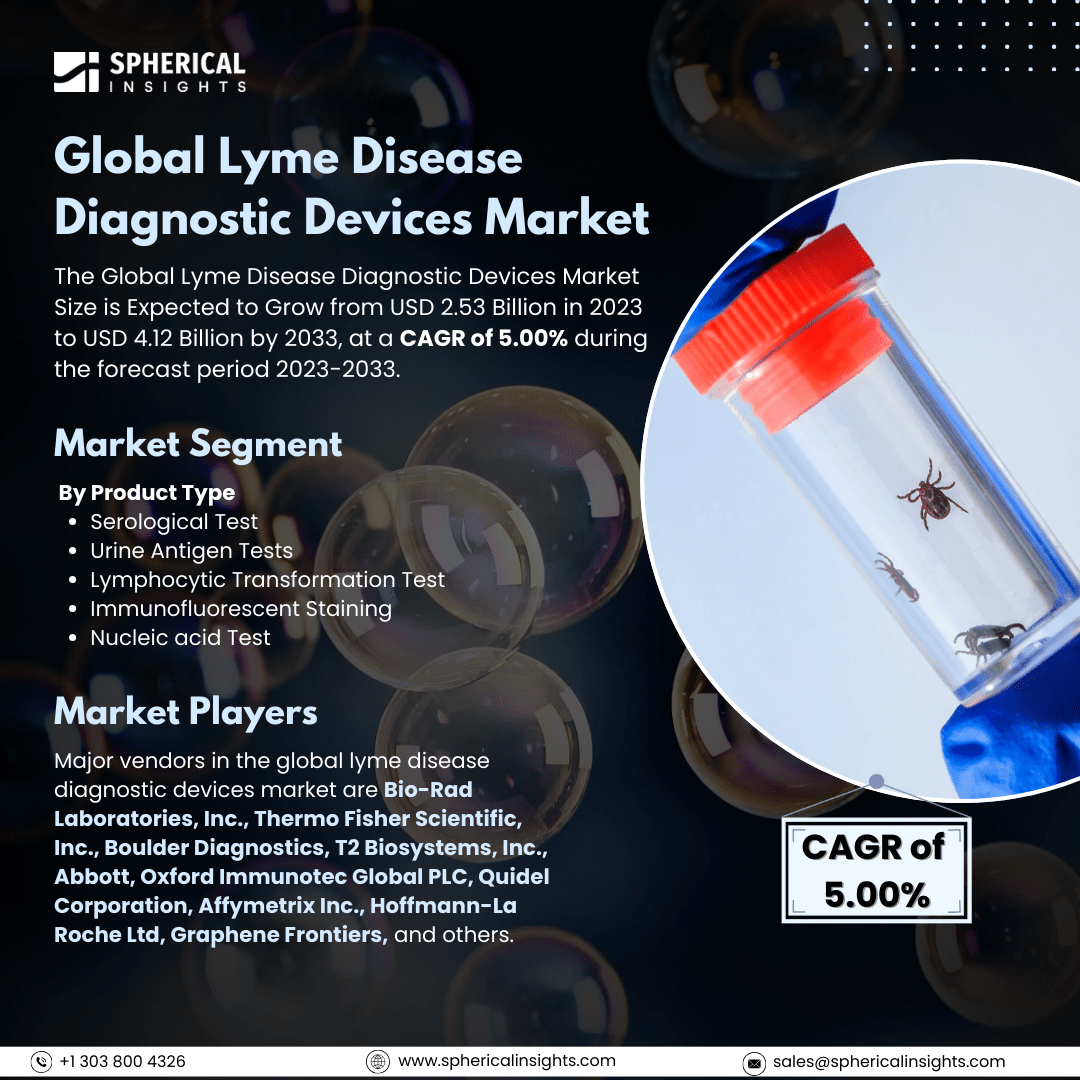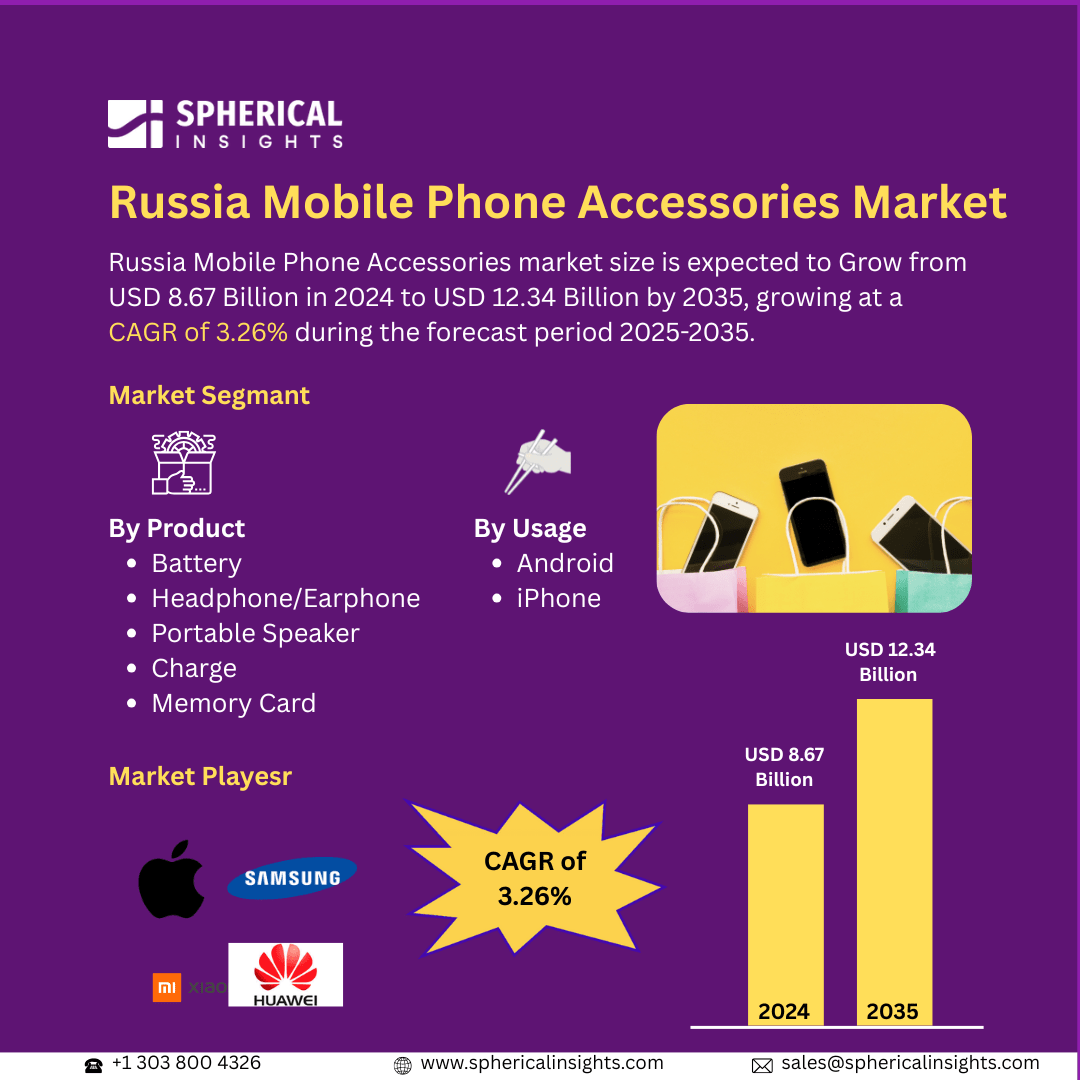Global Lyme Disease Diagnostic Devices Market Size to Exceed USD 4.12 Billion by 2033
According to a research report published by Spherical Insights & Consulting, The Global Lyme Disease Diagnostic Devices Market Size is Expected to Grow from USD 2.53 Billion in 2023 to USD 4.12 Billion by 2033, at a CAGR of 5.00% during the forecast period 2023-2033.
Browse 210 market data Tables and 45 Figures spread through 190 Pages and in-depth TOC on the Global Lyme Disease Diagnostic Devices Market Size, Share, and COVID-19 Impact Analysis, By Product Type (Serological Test, Urine Antigen Tests, Lymphocytic Transformation Test, Immunofluorescent Staining, and Nucleic Acid Test), By End-User (Hospitals, Public/Private Laboratories, and Physician’s Office), and By Region (North America, Europe, Asia-Pacific, Latin America, Middle East, and Africa), Analysis and Forecast 2023 – 2033
The lyme disease diagnostic devices market is the international market that is engaged in developing, manufacturing, and distributing diagnostic equipment and instruments to identify Lyme disease, which is a bacterial infection transmitted by ticks caused by Borrelia burgdorferi. Furthermore, the market is influenced by rising cases of Lyme disease, growing tick populations in response to global warming, and awareness regarding early detection. Developmental advancements in diagnostic tools, government support for disease management, enhanced healthcare infrastructure, and the need for quick and reliable testing further drive the market. Increased research and development activities also play their part in driving innovation. However, the high diagnostic costs, limited test accuracy, lack of awareness, misdiagnosis issues, inadequate healthcare access in rural areas, and stringent regulatory approval processes are key restraints for the growth of the market.
The serological test segment accounted for the largest share in 2023 and is anticipated to grow at a significant CAGR during the forecast period.
On the basis of the product type, the global lyme disease diagnostic devices market is divided into serological test, urine antigen tests, lymphocytic transformation test, immunofluorescent staining, and nucleic acid test. Among these, the serological test segment accounted for the largest share in 2023 and is anticipated to grow at a significant CAGR during the forecast period. The segmental growth is attributed to its widespread use, high reliability in detecting Lyme disease antibodies, and cost-effectiveness. Advancements in ELISA and Western blot techniques, increased Lyme disease prevalence, and growing awareness drive demand, ensuring significant CAGR growth during the forecast period.
The hospitals segment accounted for the greatest share in 2023 and is anticipated to grow at a substantial CAGR over the forecast period.
On the basis of the end-user, the global lyme disease diagnostic devices market is divided into hospitals, public/private laboratories, and physician’s offices. Among these, the hospitals segment accounted for the greatest share in 2023 and is anticipated to grow at a substantial CAGR over the forecast period. The segmental growth is attributed to the availability of advanced diagnostic facilities, increased patient visits for Lyme disease testing, and improved healthcare infrastructure. Rising awareness, better access to accurate diagnostics, and growing government initiatives for early disease detection drive substantial CAGR growth over the forecast period.
North America is projected to hold the largest share of the global lyme disease diagnostic devices market over the forecast period.
North America is projected to hold the largest share of the global lyme disease diagnostic devices market over the forecast period. This is due to high disease prevalence, advanced healthcare infrastructure, and strong government support for early detection. Increased funding for research, widespread awareness programs, and the presence of key diagnostic companies further drive market growth, ensuring the region's largest share over the forecast period.
Asia Pacific is expected to grow at the fastest CAGR growth of the global lyme disease diagnostic devices market during the forecast period. This is due to increasing Lyme disease awareness, improving healthcare infrastructure, and rising investments in diagnostic technologies. Expanding access to advanced testing, government initiatives for infectious disease control, and growing research collaborations further drive market expansion, making the region a key growth hub during the forecast period.
Company Profiling
Major vendors in the global lyme disease diagnostic devices market are Bio-Rad Laboratories, Inc., Thermo Fisher Scientific, Inc., Boulder Diagnostics, T2 Biosystems, Inc., Abbott, Oxford Immunotec Global PLC, Quidel Corporation, Affymetrix Inc., Hoffmann-La Roche Ltd, Graphene Frontiers, and others.
Key Target Audience
- Market Players
- Investors
- End-users
- Government Authorities
- Consulting and Research Firm
- Venture capitalists
- Value-Added Resellers (VARs)
Market Segment
This study forecasts revenue at global, regional, and country levels from 2023 to 2033. Spherical Insights has segmented the global lyme disease diagnostic devices market based on the below-mentioned segments:
Global Lyme Disease Diagnostic Devices Market, By Product Type
- Serological Test
- Urine Antigen Tests
- Lymphocytic Transformation Test
- Immunofluorescent Staining
- Nucleic acid Test
Global Lyme Disease Diagnostic Devices Market, By End-User
- Hospitals
- Public/Private Laboratories
- Physician’s Office
Global Lyme Disease Diagnostic Devices Market, By Regional
- North America
- Europe
- Germany
- UK
- France
- Italy
- Spain
- Russia
- Rest of Europe
- Asia Pacific
- China
- Japan
- India
- South Korea
- Australia
- Rest of Asia Pacific
- South America
- Brazil
- Argentina
- Rest of South America
- Middle East & Africa
- UAE
- Saudi Arabia
- Qatar
- South Africa
- Rest of the Middle East & Africa



